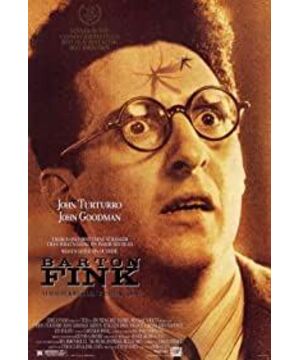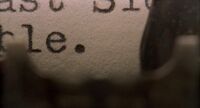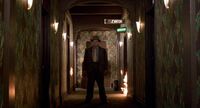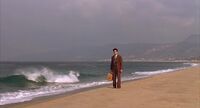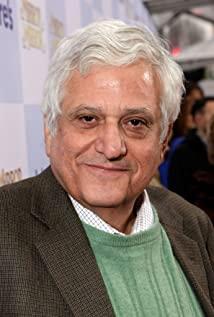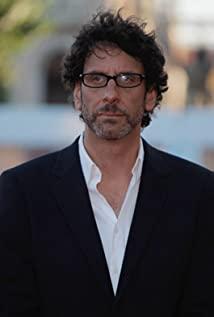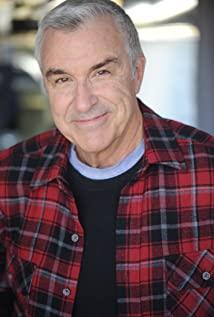No popular movie review mentions the social predicament, and I thought I was overanalysing it. I'll just say "buy insurance", "fat shame", etc. It can't be a meaningless creation. It is found that movie fans all over the world are very interested in "brain burning", but screenwriters with a level and pattern like the Coen brothers should not only use details for brain burning, their movies may be more focused on thinking and explore
Interview, Cannes, May 20, 1991, full text below
In Button Fink, as soon as we start thinking about the narrative, the story takes shape in our minds. The structure is freer than ever, and we realize that the story takes a sharp turn in the middle. We set a rhythm at the beginning of the film and engage the audience in some kind of journey. When Fink woke up to the collapse around him, we wanted that to be a surprise, but not conflict with everything that came before.
Q: "Barton Fink" deals with the subject of playwrights being hindered from writing. How did you come up with the idea to write this kind of film?
Button Funk movie poster
Joel Cohen : We were writing the script for Miller's Crossing , and we were halfway through the concept. This includes not only the writer's writing bottleneck and the trouble of not keeping up with the writing speed, but also the eagerness to keep a distance from "Miller's Crossroads". To escape the conundrum we had on that project, we started to come up with a script with a very different theme, which is two of the reasons for Button Fink . First, we wanted to work with John Turturro, whom we have all known for a long time. So we had to come up with a role that he could play. Next came the idea of a huge abandoned hotel. The idea precedes determining where the story takes place - Hollywood.
Ethan Cohen : To finish Miller's Crossroads, we had the script done in three weeks and then moved on to Miller's script. This is one of the reasons why the two films were released one after the other. By the time we finished shooting Miller, we had a script that we could shoot straight away.
Q: Why did you set the story in 1941, a pivotal year for Hollywood screenwriters? (Fitzgerald and West had just passed away, when Preston Sturges and John Huston, who had worked as screenwriters, began their directing careers.)
Joel: We didn't know that in advance. In retrospect, 1941 was the beginning of World War II for the United States, when the world outside this hotel was busy finding itself on the eve of the apocalypse, which ignited our creative passion, and that time fit the story. Another reason and what we never really realize or unfold in the film is that we consider other people leaving because of the war, so it's a hotel full of old people, lunatics, disabled people. As the script unfolded, this theme was more and more left behind, but it led us to set the time in that period in the first place.
Ethan: Another reason is the protagonist: a serious playwright, honest, involved in politics, and very naive. It seems natural that he came from the Thirties and the Colleagues.
Joel: In the writers' camp, this character shares the same era as Clifford Odets, but it doesn't end there. Both have written the same kind of play that celebrates the heroes of the proletariat, but their personalities are very different. Audens is more outgoing, in fact he is very sociable even in Hollywood, Button Fink is clearly not! Ordens himself is also very different from Ordens as a playwright. In him, passion and innocence coexist.
Q: Have you read the diaries written by Audens in the 1940s?
Ethan: John Turturro really read it. But you have to take into account the difference between a real person (in history) and a character (in the script, in the film).
Joel: Turturro is also interested in the theatrical style of the theater. At the beginning of the film, the voiceover is Turturro, and, at the end, when he types out the script on the typewriter, it must be in the Odense style.
"Barton Fink" movie stills
Q: The role of WP Mayhews was directly inspired by Faulkner.
Ethan: Yes, this writer from the South is an alcoholic. Of course, we're because of John Mahoney because he's like Faulkner, but also because we'd love to work with him, but that's just the beginning, and the resemblance between the two is superficial. As far as the characters themselves are concerned, Mayhew is very different from Faulkner, and Faulk's experience in Hollywood is not the same as his.
Joel: Of course Faulkner wasn't a Hollywood guy like Mayhew, but his alcoholism didn't ruin him, he stayed productive.
Q: Did you draw inspiration from Louis B. Mayer when creating Jack Lipnick?
Joel: Michael Lena looks a little like Mailer, but Lipnick is a mix of celebrities. The idea for the uniform came from Jack Warner, who arranged for a military council to come under his jurisdiction and ordered the costume department Make a uniform for him. Lipnick also has his commoner side, like Harry Cohen (Columbia Films' trader).
Ethan: Ironically, the Colonel's uniform is one of the most surreal elements of the film, and it's one of the few scenes (in the film) taken from Hollywood history.
director coen brothers
Q: One of the most iconic elements of your film, especially in Button Funk, is that the structure of the film is completely unpredictable. Did you think about structuring the whole film like this at the script stage?
Joel: In this film, as soon as we start thinking about the narrative, the story takes shape in our minds. The structure is freer than ever, and we realize that the story takes a sharp turn in the middle. We set a rhythm at the beginning of the film and engage the audience in some kind of journey. When Fink woke up to the collapse around him, we wanted that to be a surprise, but not conflict with everything that came before.
Ethan: We know we're walking a tightrope. We need to surprise the audience without taking him out of the story. The way we represented the hotel implied that Funk's coming to Hollywood wasn't exactly "normal." What is certain is that this one has nothing to do with genre conventions, like, for example, "Miller's Crossing" is a complete appendage to the bandit convention.
Button Funk movie poster
Q: At what stage did you start thinking about the woman on the beach at the end of the film?
Joel: It didn't take long after we started wondering what was in Button Fink's room. What we thought was that the room should have almost no decoration, the walls are blank, and the view from the window is not worth looking at. In fact, what we wanted was for the only opening to the outside world to be that painting. Creating a sense of isolation seems important to us. We want to make the protagonist feel confused from the very beginning.
Ethan: The beach imagery is comforting. I don't know for sure if we're too obsessed with this detail, but there's no doubt that this one punctuation actually adds to the depression in the interior. The movie veers from social comedy to fantasy as the plot progresses to the point where Funk slaps the mosquito.
Joel: Some people said the whole second part of the film was just a nightmare. But that was never our original intention in any literal sense - to describe some nightmare, but we do pursue irrational logic. We wanted the atmosphere of the film to reflect the psychological state of the protagonist.
Ethan: It's true to say that we want to share the inner workings and perspective of Button Fink with the audience. But there is no need to go further. For example, it would be inappropriate to have Button Fink wake up at the end of the film, we want him to live in a place that is closer to reality than the film depicts. In any case, it is always unreliable to talk about "reality" based on an artistic image. We didn't want to give the impression that he was more "real" than the story itself.
Joel: Next thing to say. No one knows what killed Audrey Taylor. We do not want to rule out the possibility that Patton killed him, despite his repeated innocence. One of the old tricks of classic crime movies is to present misleading clues to the audience for as long as possible. In other words, we want to get the suspense to the end, well, I confess, the murderer is Charlie in the next room.
Q: From both of the above points of view, John Goodman was cast as Charlie Meadows because he often plays attractive characters and audiences identify with him as soon as he appears.
Ethan: This character is also written for the playwright, and we know very clearly that this kind-hearted character exists for the psychological projection of the audience. Only in this way, the audience will relax. We subverted this expectation. Even so, When he appears, threats and unease still accompany him.
Q: The fact that Barton Fink uses/frames working class images like that in his script forces him to be friendly to Meadows, otherwise, he's contradicting himself.
Joel: Partially true, but Charlie also earned Patton's friendship through his friendly greeting.
Ethan: Of course Charlie also knew that the role that Barton Fink wanted him to play was irrational (low-class working class?).
Director Roman Polanski
Q: When the film was filming, you weren't sure if you were going to Cannes, much less expect Roman Polanski to be president of the jury. The irony is where Le locataire (1976) and Cul - de-sac (1966) meet Repulsion (1965). Directed for Polanski, but only the first went to Cannes, the other two went to Berlin) Polanski decides which one wins the grand prize.
Joel: We were obviously influenced by his films, but at this point we were hesitant to tell him that because we didn't want to come across as flattering. We learned a lot from the three films you mentioned. Button Funk does not belong to any genre, but belongs to a series of films, and Polanski is naturally the initiator of this series.
Q: Some people think that the film was also inspired by The Shining , the fictional world of writer Kafka, dark humor, and Jewish culture in Central Europe.
Joel: That's all true, except that The Shining falls into a broader category than horror. Some other critics mentioned Kafka, which surprised me, and to be honest, I didn't read him since I devoured things like The Metamorphoses in college, and these people mentioned The Castle and In the Place of Penalty, which I have never read.
Ethan: After being moved by the persevering journalists who wanted us to admit to being inspired by The Castle, I found myself intrigued to take a look at the work.
Q: How did you divide the work on the script?
Ethan: We collaborate very informally, simply. We discuss each scene in detail together, never dividing the writing. I am in charge of typing. As we said, Button Funk progressed like a wilting plant, while Miller's Crossing slowed down and took more time, almost nine months.
Joel: Usually, we spend four months on the first draft, show it to a friend, and then take another two months to finalize it.
Miller's Crossroads movie poster
Q: Can you explain why Barton Fink was completed so quickly?
Ethan: Probably because in the midst of all the conundrums that Miller's Crossing caused, we felt a sense of relief from writing this script. In any case, writing this play is so easy.
Joel: It's weird but the whole movie is almost entirely in my head. You know what they're going to be like, seeing the way they're talking, and you can't predict how they'll end up, and your gut tells you that there will be some kind of emotion that will come out naturally at the end of the credits. Other episodes, by contrast, are kind of like gradual journeys - you don't really know where you're going to be. In this movie, we know the actual question of where Button Fink ends up going. And when we started writing Charlie's last speech was when he explained himself that Barton Funk was just a tourist in the city. A lot of things are a lot easier when you know in advance where you're going to lead the character.
Ethan: We have to say that we think we know these characters well, maybe because we are so close to these two playwrights that it made it easy to write their characters.
Q: "Miller's Crossroads" is a film with many characters, places, and plot lines.
Joel: "Barton Fink" does have a smaller format. Miller's Crossroads narrative is so complicated because we created it with the intention of getting lost in the story.
Ethan: Button Funk is an extension of the concept, whereas Miller's Crossroads is a relatively plot-entangled story.
Q: How did you come up with the title?
Joel: We came up with the script that was killed when it was first written, but we found that neither of us remembered why the script was killed. It seems completely accidental.
Q: There's a lot of humor in the film, from when the wallpaper starts falling off to when a pair of cops enter the plot. In fact, the combination of drama and comedy is more evident in this film than in previous films.
Joel: It's not fair. The film is neither a drama nor a comedy. "Miller's Crossing" is more of a drama, and "Raising Arizona" is more of a comedy.
Ethan: It doesn't look like we can write a movie (screenplay) that isn't laced with comedic elements in any way.
Joel: It's funny because when I started working on Miller's Crossing, Button Funk was more of a dark comedy/gloomy comedy to me. Types of movies that show humor and fun. Such as "Dr. Strangelove" , "Catch-22" , "Bump to the Right" ).
Ethan: Contrary to Miller, we torture the protagonist for comic effect.
'Button Funk' movie poster starring John Turturro
Q: John Turturro played the same character he did in Miller's Crossing. In both films, he had a humiliating ending.
Ethan: You overlooked the fact that in Button Funk the character was abused for twenty years. In the end, he got used to it (and no shame).
Q: The first Hollywood scene seemed different: a rock on the beach.
Interesting you should note because we did shoot other scenes just to be conservative, but we both decided not to use those in the end. All we need is a rock on the beach that heralds the end of the film.
This is your second collaboration with art director Dennis Geisner.
Joel: We shot at the hotel for at least three weeks and half of the film was used there. We wanted an Art Deco style and a place that had boomed and fallen into decline. The hotel had to be organically linked to the film. We wanted the hotel to exist more as an externalization of the character played by John Goodman (Fat Man). Sweat slid from his forehead like wallpaper peeling off the wall. At the end, when Goodman says he's a prisoner of his own demons, that requires the hotel to be as close as hell.
Ethan: We used a lot of green and yellow to express the corrupt atmosphere.
Joel: Ethan always compares the hotel to a ghost ship wandering around, where you don't even have to look to notice the presence of other travelers. The only traces they left were shoes in the hallway. You can see these failed traveling salesmen with miserable sex lives, crying alone in the room.
Q: When you look back on Hollywood fifty years ago, you find yourself stuck with the same problem in different ways. Do artists always run into mortals like Lipnick?
Joel: We have to say maybe yes. But Barton Fink is indeed very different from our own experience. It's certainly bizarre and unfair that our careers in Hollywood have been surprisingly smooth. We have not been troubled by criticism. Our debut, Blood Maze, was self-funded, and Washington-based Circle Films Inc. produced the next three. Every time, we give them a script, they like it, and they agree to (our) budget. There are no rejected scripts in our drawers. There are a lot of books that have started, and for one reason or another, we haven't finished, either because there are artistic issues we haven't made up our minds to solve, or because the production costs are too high.
photographer Roger Deakins
Q: Are there any of these aborted projects that you particularly like?
Joel: No, because you're immediately obsessed with the next movie, which becomes your only urgent task. We originally wanted to make one or two short films that we wrote ourselves, but it was very difficult to do that in the US because there was no market.
You have used Roger Deakins ( The Great Thunder / The Old Woman Killer / The Absentee / No Country for Old Men / Serious Men / Button Funk photography) for this kind of project, yes ?
Joel: Our usual photographer , Barry Sonnenfeld, didn't have time, because we had seen and liked Deakins' work, so we asked him to collaborate. He looks like a good fit for this one.
Ethan: We especially like the night scene of Rampage Monday and the sense of order in the interior scenes. We've also seen Sid and Nancy and Pascali's Island.
Q: Did you storyboard the film as before?
Ethan: Yes, we did more than one in detail, but of course there will always be a lot of changes once shooting starts. But by the time we got to the hotel, we had a plan for every shot in hand. It's a much easier movie to make than Miller's Crossing, and it's about a third of the budget, and the shoot cycle is the same, 12 weeks for the last one, 8 weeks for this one.
Miller's Crossroads movie poster
Q: What scenes did you shoot that were not used in the final cut?
Joel: In "Miller's Crossing," there's a whole set of shots that disappear from the film. It's different from Button Funk, where we used almost every shot we ever shot. But I do remember that we did some behind-the-scenes shots of Hollywood work and decided not to stay because they were too standard.
Q: Compared with the previous films, like "Miller's Crossing", which has a bold attempt at night scene shooting, Barton Funk's style is more restrained and low-key.
Joel: We didn't realize it ourselves. It could be that Miller's Crossing has so many dialogue scenes that we came to a point where we wanted to give the audience an engaging visual. Its genre also encourages mass action. But in this film, this kind of visual effect is not suitable. The stylistic tricks can upset the balance of the whole film.
Q: The screenwriter who got tricked by Hollywood was part of what made the film legendary.
Ethan: Yes, the old yellow calendar. We were more trying to give the two writers in the film the dignity of the victims, and maybe they didn't deserve it, because Barton Fink wasn't a great artist and Mayhew couldn't write anymore.
Q: Who do you feel you are walking closer to in the American film industry?
Joel: We have a lot of ideas, but we don't see any connection to our work. The contemporary American film industry is doing well; some directors have been very successful in expressing their aspirations and borrowing their lyricism. In fact, there are two kinds of movies in America today, those driven by big studios, mostly repeating the same routines, although there are exceptions, and those of independent movies where the director speaks.
Q: Your films stand in stark contrast to most contemporary Hollywood productions. For example, all of your films go right into the set and don't give long shots/setting shots, like Miller's Crossing.
Joel: At the beginning of Miller's Crossing, we had two plans: the first was a glass with ice cubes, and then there was a close-up of Polito. We don't want to directly show who is holding the cup. You see someone walking next to the cup, you hear the tinkling of ice cubes, but the character is out of sight. Then you see Polito, you hear his monologue, the ice cubes are always part of the scene, but that escapes the point of view. Then you see Albert Finney, but you still don't know who's holding the cup, and finally, you see Gabriel Byrne in the background. It's all laid out on the storyboard.
Ethan: We wanted to create an atmosphere of mystery around this character who became a hero.
Joel: Polito is important in this scene because he is the one who starts the story and also provides the background information.
Ethan: We kept Gabriel out of this conversation. He was the last to speak, five minutes into the film.
Q: How do you explain that although "Miller's Crossing" has been praised by critics around the world, it has not been as good at the box office?
Ethan: Box office issues are always hard to reason about. It's probably the plot that makes the audience overwhelmed.
Joel: The whole plot of The Big Sleep (1946) is hard to understand after all! It's hard to predict the future of the box office, but we were blown away by the numbers anyway.
View more about Barton Fink reviews


